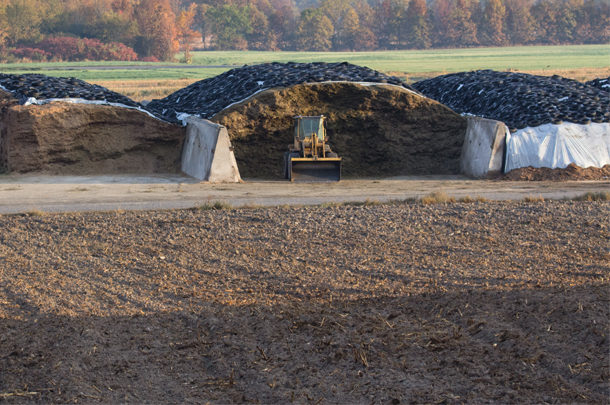Canadian dairies, in particular, might want to consider further testing their TMRs for mold and mycotoxins before adding wheat on top.
The annual study surveyed corn silage samples from across the U.S. and Canada from September to November 2015, testing for mycotoxin contamination to determine the risk posed to ruminant animals. The mycotoxin analysis, which detects for more than 37 individual mycotoxins in a given feedstuff, found an average 5.6 mycotoxins per sample, with 71 percent of samples testing at high risk to dairy.
The harvest analysis revealed multiple mycotoxins present in 2015 Canadian corn silage, showing the greatest risk for Type A Trichothecenes, Type B Trichothecenes and other Penicilliums. The increased risk of Type A Trichothecenes and Penicilliums together in the 2015 crop pose a heightened risk compared to 2014.
While corn silage risk can be lowered by the inclusion rate in silage, it is important for dairy producers to also consider the quality of the wheat crop before including it in the TMR. In Canadian wheat samples alone, the results showed an average 2.6 mycotoxins per sample. Wheat added as an energy and protein source can increase the risk, particularly to calves.
Calves are specifically at a high risk due to age and an immature immune system. These types of toxins can impair growth and development, impacting first-lactation performance and subsequent lifetime production.
Scientific literature shows that dairy cows may produce 0.61 litres of milk per day less when consuming mycotoxins at high-risk levels. Additionally, milk somatic cell count (SCC) may increase by 48.8 percent. Considering current milk prices, producers could see an estimated reduction in profitability per cow at $67.27 over one lactation with this loss in performance.
When looking at the impact of mycotoxins on animal health and performance, more information is advantageous. Multiple mycotoxins were found in more than 97 percent of all feed samples analyzed.
For example, a sample of corn silage can have five mycotoxins present, all at low risk, but four of the five can have a negative impact on dry matter intake (DMI). Therefore, a negative impact on DMI may now be at a more moderate risk due to additive effects. There can be synergistic effects where one mycotoxin can magnify the effect of another, even at low levels.
The survey sets the baseline for forage quality when producers start feeding the 2015 crop. The crop condition at harvest and the storage environment (temperature, oxygen, moisture) will determine if these levels rise during storage and increase the risk to cows.
Weather stress, pest damage or delayed harvest can give mycotoxin-producing molds a greater foothold in the plant. This brings not only increased mycotoxins with the crop but also additional mold spores that can produce more mycotoxins while in storage.
Mycotoxin production in storage is dependent on packing density, oxygen exposure, face management and temperature. When corn silage is harvested drier, the ability to achieve proper packing density is decreased and results in poorer fermentation and greater oxygen exposure.
Producers should also check forage and grain storage management:
- Is corn silage that is bad (on top or in pockets) being pitched off and not included into the TMR?
- Is the face management or the amount fed off the face on a daily basis correct? There should be at least 6 inches fed off the face on a daily basis. This will help with oxygen penetration and the growth of molds, particularly Penicillium.
- If the silage is being hauled in from another location, do not bring more than can be fed in 24 to 48 hours. This will decrease the chance of increased mold growth.
- Stored grain should be monitored for spoilage and moisture levels. Corn that is stored at 14 percent moisture will have a variation from 12 to 18 percent moisture. This can allow mold growth and subsequent mycotoxin production as well as a decrease in nutritive value.
The use of a mycotoxin-mitigating substance (or sequestering agent) in the feed could help reduce or prevent the negative effects mycotoxins have on the animal and additionally improve rumen function and gut health and integrity.
The most effective agents are those that can help combat the risk of multiple mycotoxin contamination, as more than 97 percent of the feed samples tested have been contaminated with multiple mycotoxins. If the risk from the forage and grain has been reduced by inclusion rate and proper management, the amount of sequestering agent required will be lower – but will still be needed.
There is a historical trend that mycotoxins increase over time during storage, and stored forages and grains need to be closely monitored for increased mycotoxins. Corn silage is only one ingredient in the ration; other feedstuffs, such as wheat, can introduce additional mycotoxins. PD
PHOTO: Feeding our of silage pits. Photo by Mike Dixon.

-
Max Hawkins
- Nutritionist
- Alltech Inc.
- Email Max Hawkins









